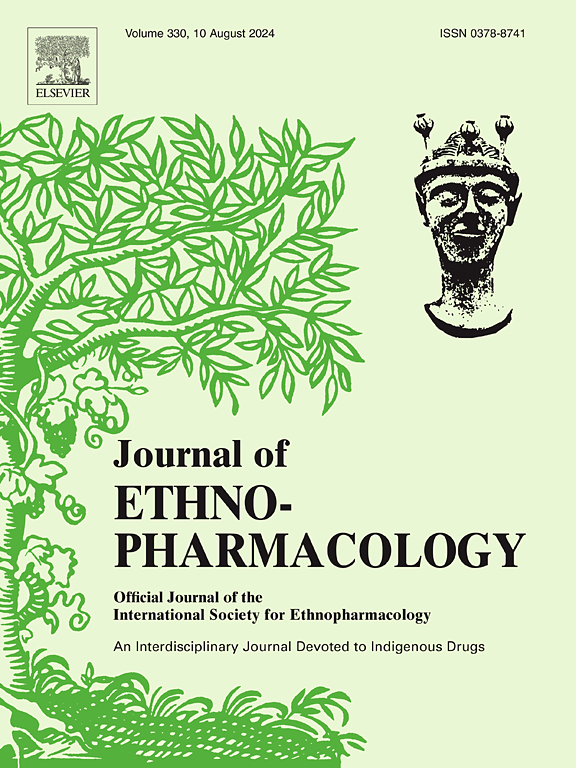Root of Prunus persica (taoshugen) ameliorated renal fibrosis by inhibiting TGF-β signaling via upregulating Pmepa1 in mice with unilateral ureter obstruction
IF 4.8
2区 医学
Q1 CHEMISTRY, MEDICINAL
引用次数: 0
Abstract
Ethnopharmacological relevance
Various parts of Prunus persica (L.) Batsch (peach) exhibit medicinal properties and are utilized in traditional Chinese medicine (TCM) for therapeutic purposes. Notably, the root of P. persica, referred to as “taoshugen” in Chinese, is utilized by experienced TCM practitioners for the treatment of liver cirrhosis, suggesting its potential efficacy in mitigating organ fibrosis.
Aim of the study
The study aimed to investigate the potential protective role of the water extract of taoshugen (WE-TSG) against chronic kidney disease-associated renal fibrosis and the underlying mechanisms.
Materials and methods
The chemical composition of WE-TSG was characterized using liquid chromatography-tandem mass spectrometry (LC-MS/MS). The anti-renal fibrosis efficacy of WE-TSG was evaluated in vitro using TGF-β1-stimulated renal tubular TCMK1 cells and in vivo using a murine model of unilateral ureter obstruction (UUO). The underlying mechanisms were elucidated using RNA-seq and CRISPR/Cas9-mediated loss of function of candidate genes. The activity of TGF-β signaling and the extent of fibrosis were determined by luciferase reporter assays, histology, immunohistochemistry, RT-PCR, and Western blot.
Results
LC-MS/MS analysis identified 14 major compounds in WE-TSG, primarily flavonoids and organooxygen compounds. In TCMK1 cells, WE-TSG significantly inhibited the activity of TGF-β-responsive luciferase reporters, CAGA-luc and CTGF-luc, and dose-dependently (3.125, 6.25, and 12.5 μg/mL) suppressed TGF-β1-induced Smad2/3 phosphorylation (p-Smad2/3) and fibrotic gene (fibronectin, Col1a1, and Ctgf) expression, without affecting total Smad2/3 protein levels. In vivo, oral administration of WE-TSG (1.4 and 2.8 g/kg) attenuated structural abnormalities, collagen deposition, and fibrotic gene (fibronectin, Col1a1, and α-SMA) expression, alongside reduced TGF-β signaling activity (TGF-β1 and p-Smad2/3) in the kidney tissues of UUO mice. RNA-seq in TCMK1 cells identified that Pmepa1, a negative-feedback regulator of TGF-β signaling, was significantly upregulated upon WE-TSG pretreatment. Importantly, knockout of Pmepa1 abolished the anti-TGF-β signaling and anti-fibrosis effects of WE-TSG in TGF-β1-stimulated TCMK1 cells. Moreover, kidney-targeted Pmepa1 knockdown also abrogated the anti-renal fibrosis role of WE-TSG in UUO mice.
Conclusions
Our findings demonstrate that WE-TSG inhibits TGF-β signaling and attenuates UUO-induced renal fibrosis by promoting Pmepa1 expression, highlighting the potential of herbal medicine taoshugen in the clinical treatment of CKD.

桃李根通过上调Pmepa1抑制TGF-β信号通路改善单侧输尿管梗阻小鼠肾纤维化
民族药理学相关性:桃李(L.)不同部位桃具有药用特性,在传统中医(TCM)中用于治疗目的。值得注意的是,有经验的中医医生用桃树根治疗肝硬化,这表明它有减轻器官纤维化的潜在功效。研究目的:探讨桃树根水提物(WE-TSG)对慢性肾脏疾病相关肾纤维化的保护作用及其机制。材料与方法:采用液相色谱-串联质谱(LC-MS/MS)对WE-TSG的化学成分进行了表征。体外采用TGF-β1刺激的肾小管TCMK1细胞,体内采用单侧输尿管梗阻(UUO)小鼠模型,评价e - tsg抗肾纤维化的作用。利用RNA-seq和CRISPR/ cas9介导的候选基因功能丧失来阐明潜在的机制。采用荧光素酶报告基因法、组织学、免疫组化、RT-PCR、western blot检测TGF-β信号活性及纤维化程度。结果:LC-MS/MS分析鉴定出14种主要化合物,主要为黄酮类化合物和有机氧化合物。在TCMK1细胞中,w - tsg显著抑制TGF-β响应荧光素酶报告基因CAGA-luc和Ctgf -luc的活性,并呈剂量依赖性(3.125、6.25和12.5 μg/mL)抑制TGF-β1诱导的Smad2/3磷酸化(p-Smad2/3)和纤维化基因(纤连蛋白、Col1a1和Ctgf)的表达,但不影响Smad2/3总蛋白水平。在体内,口服WE-TSG(1.4和2.8 g/kg)可减轻UUO小鼠肾组织中的结构异常、胶原沉积和纤维化基因(纤维连接蛋白、Col1a1和α-SMA)的表达,同时降低TGF-β信号传导活性(TGF-β1和p-Smad2/3)。TGF-β信号通路的负反馈调节因子Pmepa1在WE-TSG预处理后显著上调。重要的是,敲除Pmepa1可消除TGF-β信号传导和TGF-β刺激的TCMK1细胞中WE-TSG的抗纤维化作用。此外,肾靶向Pmepa1敲低也使WE-TSG在UUO小鼠中的抗肾纤维化作用失效。结论:我们的研究结果表明,WE-TSG通过促进Pmepa1的表达,抑制TGF-β信号,减轻uuo诱导的肾纤维化,突出了中药桃树根在CKD临床治疗中的潜力。
本文章由计算机程序翻译,如有差异,请以英文原文为准。
求助全文
约1分钟内获得全文
求助全文
来源期刊

Journal of ethnopharmacology
医学-全科医学与补充医学
CiteScore
10.30
自引率
5.60%
发文量
967
审稿时长
77 days
期刊介绍:
The Journal of Ethnopharmacology is dedicated to the exchange of information and understandings about people''s use of plants, fungi, animals, microorganisms and minerals and their biological and pharmacological effects based on the principles established through international conventions. Early people confronted with illness and disease, discovered a wealth of useful therapeutic agents in the plant and animal kingdoms. The empirical knowledge of these medicinal substances and their toxic potential was passed on by oral tradition and sometimes recorded in herbals and other texts on materia medica. Many valuable drugs of today (e.g., atropine, ephedrine, tubocurarine, digoxin, reserpine) came into use through the study of indigenous remedies. Chemists continue to use plant-derived drugs (e.g., morphine, taxol, physostigmine, quinidine, emetine) as prototypes in their attempts to develop more effective and less toxic medicinals.
 求助内容:
求助内容: 应助结果提醒方式:
应助结果提醒方式:


